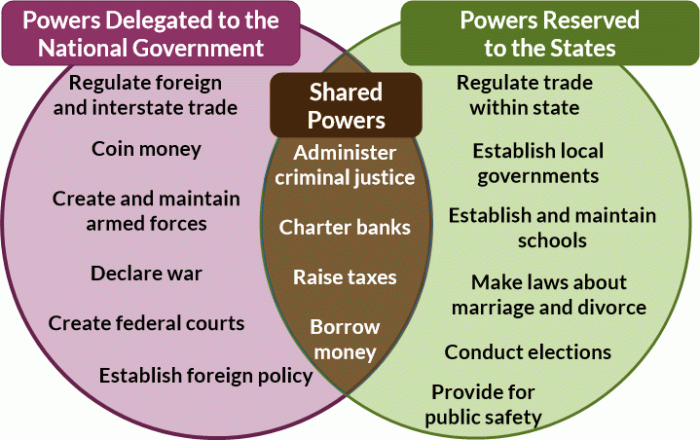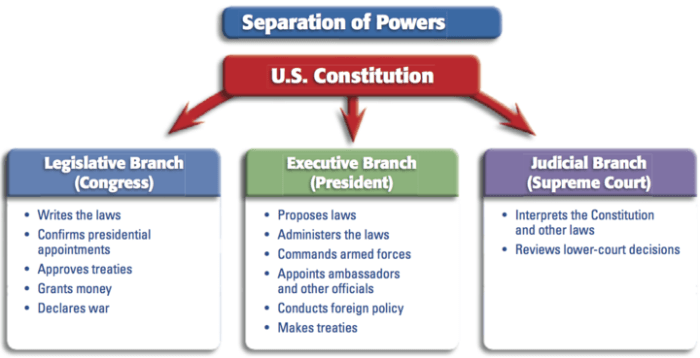The separation of powers venn diagram serves as a visual representation of the fundamental principle of dividing government authority among distinct branches. This concept, ingrained in democratic systems, ensures that no single entity holds absolute power, thereby safeguarding individual liberties and preventing tyranny.
The diagram illustrates the three branches of government—legislative, executive, and judicial—and their respective powers. Each branch possesses unique functions and responsibilities, yet they overlap in certain areas, creating a system of checks and balances that fosters accountability and prevents any one branch from becoming too powerful.
Separation of Powers in a Venn Diagram: Separation Of Powers Venn Diagram

The separation of powers is a constitutional principle that divides the powers of government into three branches: the legislative, executive, and judicial branches. This division of power is designed to prevent any one branch from becoming too powerful and to protect the rights of citizens.
In the United States, the legislative branch is responsible for making laws. The executive branch is responsible for enforcing laws and carrying out the policies of the government. The judicial branch is responsible for interpreting laws and resolving disputes.
The separation of powers is illustrated in a Venn diagram as three overlapping circles. Each circle represents one branch of government, and the overlapping areas represent the powers that are shared by two or more branches.
Checks and Balances
The system of checks and balances is a way to ensure that no one branch of government becomes too powerful. Each branch of government has the power to check the powers of the other branches.
- The legislative branch can pass laws to override executive orders.
- The executive branch can veto laws passed by the legislative branch.
- The judicial branch can declare laws passed by the legislative branch unconstitutional.
The system of checks and balances helps to ensure that no one branch of government can become too powerful and that the rights of citizens are protected.
Advantages of Separation of Powers
There are many advantages to separating powers in government. Some of the most important advantages include:
- Prevents tyranny:The separation of powers makes it difficult for any one person or group to gain too much power. This helps to prevent tyranny and protect the rights of citizens.
- Promotes efficiency:The separation of powers helps to promote efficiency in government. Each branch of government has its own specific role to play, and this helps to avoid duplication of effort.
- Protects individual rights:The separation of powers helps to protect individual rights. Each branch of government has the power to check the powers of the other branches, and this helps to ensure that no one branch can infringe on the rights of citizens.
The separation of powers is a fundamental principle of American government. It has helped to protect the rights of citizens and ensure the efficient functioning of government for over 200 years.
Disadvantages of Separation of Powers, Separation of powers venn diagram
There are also some disadvantages to separating powers in government. Some of the most important disadvantages include:
- Can lead to gridlock:The separation of powers can sometimes lead to gridlock in government. If the different branches of government cannot agree on a course of action, it can be difficult to get anything done.
- Can be inefficient:The separation of powers can also be inefficient. Each branch of government has its own bureaucracy, and this can lead to duplication of effort and waste.
- Can make it difficult to respond to crises:The separation of powers can make it difficult for the government to respond quickly to crises. If the different branches of government cannot agree on a course of action, it can take time to get anything done.
Despite these disadvantages, the separation of powers is still a fundamental principle of American government. It has helped to protect the rights of citizens and ensure the efficient functioning of government for over 200 years.
Clarifying Questions
What is the purpose of the separation of powers?
The separation of powers aims to prevent any one branch of government from becoming too powerful and potentially tyrannical by distributing authority among distinct branches.
How does the system of checks and balances work?
Each branch of government has the ability to check the powers of the other branches. For instance, the legislature can make laws, but the executive can veto them, and the judiciary can declare them unconstitutional.
What are some advantages of the separation of powers?
The separation of powers helps to prevent tyranny, promotes accountability, and safeguards individual liberties.


